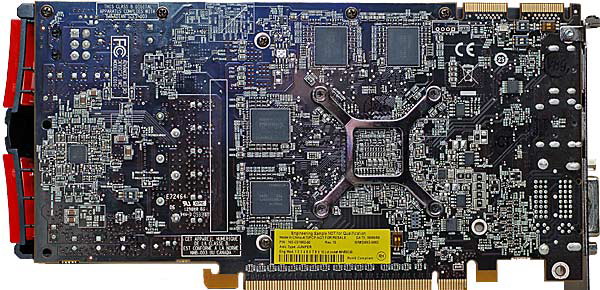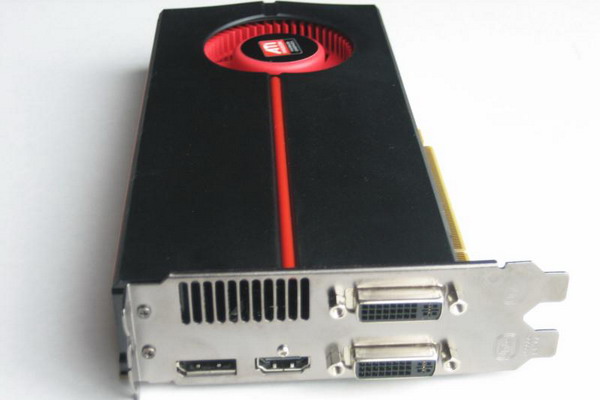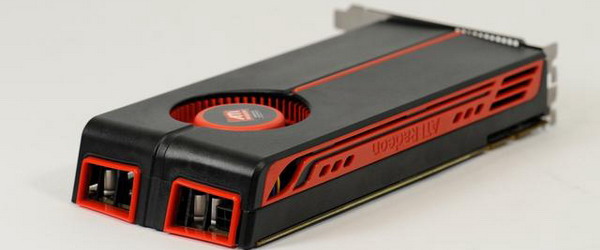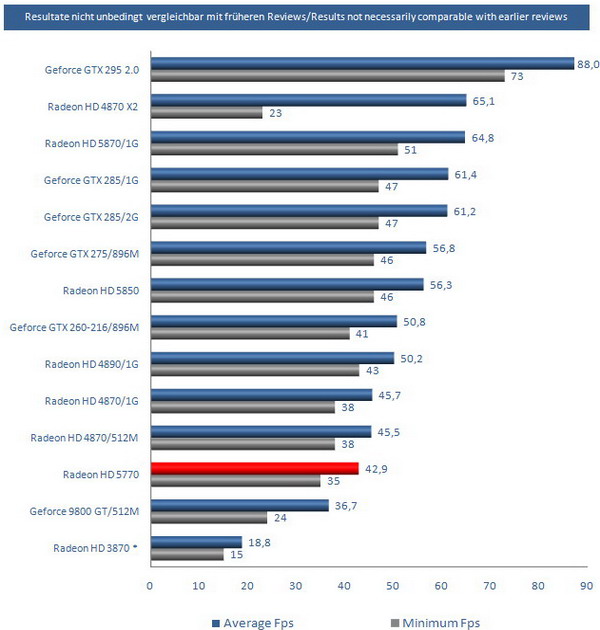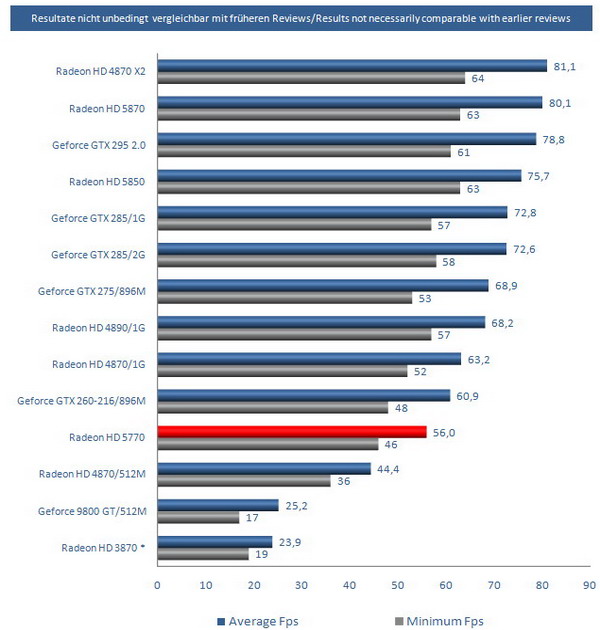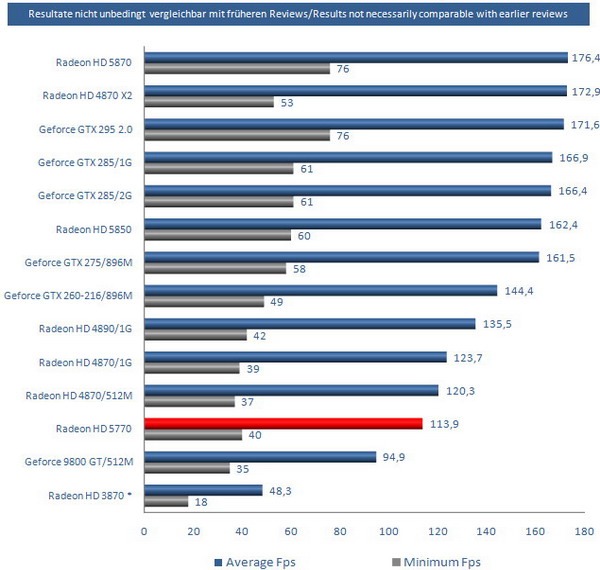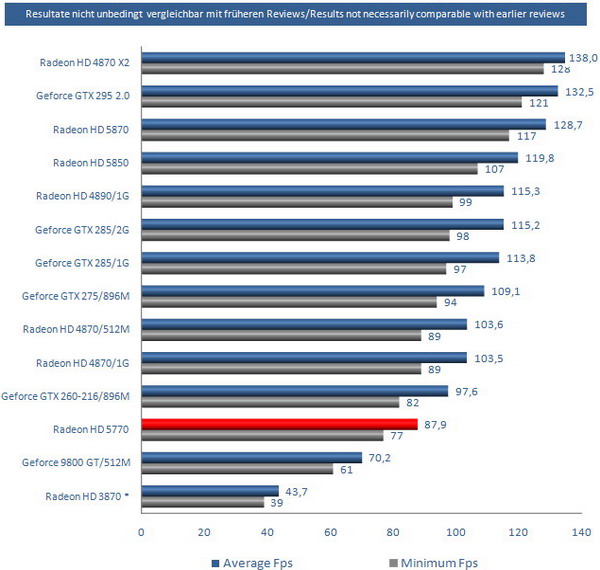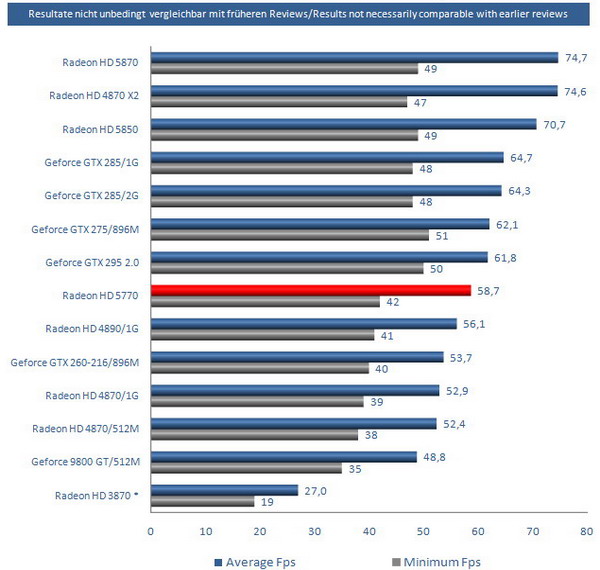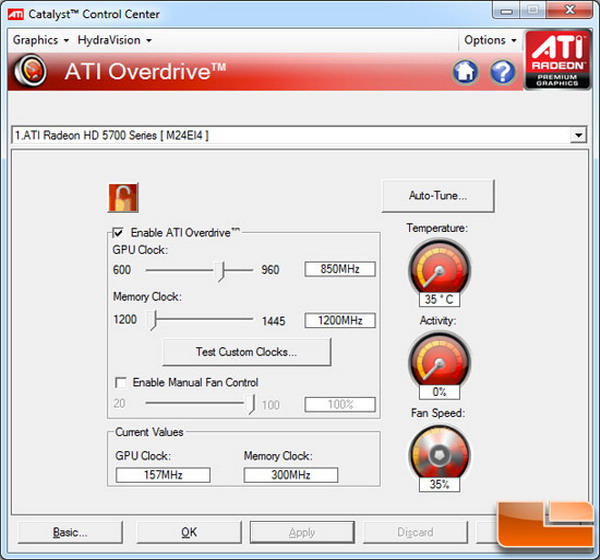
ATI Radeon HD 5770 1GB
Hardware 0 CommentsIntroduction
The 5770 is a drop-in replacement for the 4870. It has the same basic amount of GPU processing power, albeit on a smaller process with much better power management. So the improvements are all elsewhere–DirectX 11 being the most prominent, but you gotta highlight the rest: Eyefinity multi-monitor support, 1GB RAM stock, HDMI 1.3a with onboard audio, super-sample anti-aliasing, and a smaller, lighter design. It’s also really, really cheap. So the question is, should you hock your 4800-series card for one of these? I’ll let the benchmarks do the talking.
I talked to 5700-series manager Dave Vizera on the 5700, and had a few questions (these are slightly paraphrased).
Me: How’s the yield?
Dave: We had tens of thousands of cards before the launch, and yields are good. This is our second-wave of 40nm cards. We got all the wrinkles out with 4700-series, so we know what we’re doing.
Me: So you’ll keep up with demand?
Dave: It’s a great product.
Me: Is a dual-GPU 5700-series card in the works?
Dave: We make 5800-series cards, too.
Me: Do you know of any new upcoming DirectX 11 titles?
Dave: You know, we’ve sent video cards out to about 100 developers for DX11 adoption. This is an opportune time to switch to AMD, and our target buyer is the gamer buying a new computer, or the once-per-year upgrader. We firmly support games development and DirectX 11. I don’t know if you’ve played around with home theater PCs, but–
Me: Oh absolutely. I never watch live TV.
Dave: Well then you should think about getting a 5700-series video card. I don’t know if you’ve ever played games on an HDTV but it’s a completely mind-blowing experience. On top of that, HDMI one point three audio, the audio processor built into the 5700-series cards is Dolby TrueHD and DTS Master-certified.
Me: Do you talk about Lucid Hydra? Do you plan to work with them?
Dave: You know, we’ve worked real hard on CrossFire, and it’s a good solution, and we’re committed to make it better all the time. And you know what? We’ve never been asked to look at Hydra. We don’t even know if it’s real.
Alright, let’s take a break and look at the hardware and run some benchmarks here. Wrapping up, we’ll get to the answers to my other questions.
The Card & Bundle
I got these cards straight from AMD, all packed in bubble-wrap with blue packing tape, but nothing you’d see in a retail box, like adapters, literature, drivers, or warrantee stuff that you look at once and promptly lose.
This card seems a lot smaller than a 4870 or 4890, and while yes, it is shorter, it’s all about the lightweight heatsink. It’s a plastic-shrouded blower-powered heatsink that exhausts both into and outside of the case. The Bat leaves his mark, the shroud is black and red with air scoop-looking power-connector openings at the front.
There are four video connections, two DVI, HDMI, and one DisplayPort, so a good chunk of the dual-slot rear of the card is unavailable, so there are additional vents along the top near the CrossFire connectors, which does mean that ventilation is (slightly) impaired by them in multi-GPU setups.
This is a stock-clocked reference design, without stickers for branding or anything fancy.
Specifications and Setup
In this review, we’ll be comparing the Radeon HD 5870 to:
- a ATI Radeon HD 5870 1GB
- a Diamond Radeon HD 4870 1GB
- a Sapphire Radeon HD 4890 1GB OC
- a PowerColor Radeon HD 4850 512MB
- a PNY GeForce 9800 GTX 512MB XLR8
- an EVGA GeForce GTX 260 896MB FTW
- and an EVGA GeForce GTX 260 896MB FTW
Test Computer Specifications
- Processor: Intel Core 2 Duo E8400 3GHz
- Motherboard: Asus Rampage Formula
- Memory: Crucial Ballistix Tracer DDR2 800 @ 4-4-4-12 (Sponsored by Crucial
- Power Supply: Thermaltake Toughpower 1000 (Sponsored by Thermaltake)
- Operating System: Windows Vista Ultimate x64 (Sponsored by Microsoft)
Video Card Specifications
From AMD
- 1.04 billion 40nm transistors
- TeraScale 2 Unified Processing Architecture
- 800 Stream Processing Units
- 40 Texture Units
- 64 Z/Stencil ROP Units
- 16 Color ROP Units
- GDDR5 memory interface
- PCI Express 2.1 x16 bus interface
- DirectX’ 11 support
- Shader Model 5.0
- DirectCompute 11
- Programmable hardware tessellation unit
- Accelerated multi-threading
- HDR texture compression
- Order-independent transparency
- OpenGL 3.2 support1
- Image quality enhancement technology
- Up to 24x multi-sample and super-sample anti-aliasing modes
- Adaptive anti-aliasing
- 16x angle independent anisotropic texture filtering
- 128-bit floating point HDR rendering
- ATI Eyefinity multi-display technology2,3
- Three independent display controllers
- Drive three displays simultaneously with independent resolutions, refresh rates, color controls, and video overlays
- Display grouping
- Combine multiple displays to behave like a single large display
- ATI Stream acceleration technology
- OpenCL 1.0 compliant
- DirectCompute 11
- Accelerated video encoding, transcoding, and upscaling4,5
- Native support for common video encoding instructions
- ATI CrossFireX’ multi-GPU technology6
- Dual GPU scaling
- ATI Avivo HD Video & Display technology7
- UVD 2 dedicated video playback accelerator
- Advanced post-processing and scaling8
- Dynamic contrast enhancement and color correction
- Brighter whites processing (blue stretch)
- Independent video gamma control
- Dynamic video range control
- Support for H.264, VC-1, and MPEG-2
- Dual-stream 1080p playback support9,10
- DXVA 1.0 & 2.0 support
- Integrated dual-link DVI output with HDCP11
- Max resolution: 2560×160012
- Integrated DisplayPort output
- Max resolution: 2560×160012
- Integrated HDMI 1.3 output with Deep Color, xvYCC wide gamut support, and high bit-rate audio Max resolution: 1920×120012
- Integrated VGA output
- Max resolution: 2048×153612
- 3D stereoscopic display/glasses support13
- Integrated HD audio controller
- Output protected high bit rate 7.1 channel surround sound over HDMI with no additional cables required Supports AC-3, AAC, Dolby TrueHD and DTS Master Audio formats
- ATI PowerPlay’ power management technology7
- Dynamic power management with low power idle state
- Ultra-low power state support for multi-GPU configurations
- Certified drivers for Windows 7, Windows Vista, and Windows XP
Speeds & Feeds
- Engine clock speed: 850 MHz
- Processing power (single precision): 1.36 TeraFLOPS
- Polygon throughput: 850M polygons/sec
- Data fetch rate (32-bit): 136 billion fetches/sec
- Texel fill rate (bilinear filtered): 34 Gigatexels/sec
- Pixel fill rate: 13.6 Gigapixels/sec
- Anti-aliased pixel fill rate: 54.4 Gigasamples/sec
- Memory clock speed: 1.2 GHz
- Memory data rate: 4.8 Gbps
- Memory bandwidth: 76.8 GB/sec
- Maximum board power: 108 Watts
- Idle board power: 18 Watts
DirectX 10 Titles
Performance Notes
It’s not a winner here by any margin. Despite being a second-wave of HD 5000 parts, the performance here is lagging behind its previous-generation competition. On paper, the 5770 should be neck-and-neck with the 4870, but this drop is telling; the drivers need time to mature.
DX9, OpenGL, and Synthetics
Performance Notes
Here the performance disparity diminishes, but is still apparent in the games. The 5770 grinds the frames out nonetheless, and has no problems with the older, but still very popular platforms. Synthetics, on the other hand, show a different story, with the 5770 slightly nudging out the previous generation.
Video, Power, and Overclocking
Like the 5800s, the 5700s have no problems delivering perfect playback. It’s starting to be a non-issue at this point, although I’m sure there are a few people who will be very happy about the dual-HD decoders, for that nasty habit of watching two movies simultaneously.
The biggest win is right here, with this card running on barely more power than what’s provided by the PCI Express slot, and that’s at full tilt. At idle, this video card needs barely more electricity than a chipset. Compared to any of the older cards, it’s just a little wonder.
And all that’s bared out by the noise, that is to say, the lack of it. It is completely inaudible at idle, and at load, the card hums so slightly that the only way you’d ever hear it is in an HTPC doing some non-gaming GPGPU work. The 5770 is easily the most quiet stock performance gaming video card ever made this decade.
Conclusion
I had other questions about the 5700-series beyond what the press briefing covered, and Dave Erskine got back to me with some emailed answers.
Me: If you add a 2nd 5700 series card to a computer, can you run 6 monitors?
Dave: Not at this time, the current driver release only supports a 3×1 display group.
Me: Can the hardware tessellation built into the HD 2-, 3-, and 4000 series take advantage of the hardware tessellation support now part of DX 11?
Dave: DirectX 11 tessellation uses an updated algorithm controlled by programmable Hull Shaders and Domain Shaders, which are only supported on HD 5000 series GPUs. (This means no unless the game designer decides to back-port tessellation themselves.)
Me: Can the perspective of a multi-monitor SLS set-up be adjusted to fit the monitor lay-out chosen by the gamer. Can adjustments be made to reflect the difference in perspective created by the monitor lay-out? (Parallax correction.)
Dave: Not at this time.
Me: Can you tell me more about the Anti-aliasing introduced in the 5000 series? I’d some comprehensive information about how it works, how it’s better than regular multi-sample AA, etc.
Dave: Adaptive anti-aliasing has been supported on ATI Radeon GPUs since the X1000 series. The new anti-aliasing feature for the HD 5000 series is called Super-sample Anti-Aliasing. We plan to release some detailed documentation on this feature shortly.
Me: Why does the 5700 series only have one rasterizer? Does this affect performance, and if not, why does the 5800 series have two?
Dave: The purpose of the rasterizer is to step through polygons and generate pixels to fill them, which are then sent to the stream processing units for pixel shading. The HD 5800 series GPUs have so much shader processing capability that a single rasterizer unit could not always feed them pixels fast enough to keep them fully utilized, so a second one was required to eliminate potential performance bottlenecks. The HD 5700 series has half the shader processing capability of the HD 5800 series, so only one rasterizer unit is required. I hope AMD decides to start working on parallax-correction because the downside of being surrounded by flat monitors is nausea; it’s a tip of the hat to the twenty or so people are gonna go Eyefinity, but a real feather in their cap. So to address the issue of upgrading: probably not worth it if you’re going from a performance-level previous-generation video card. Not that you won’t eventually see a performance improvement, these drivers are young and unrefined, but rather, it’s only a deal-maker if you’re interested in the features. It’s a hell of a feature-set, though. The 5700-series definitely has hardware worth endorsing, even if it’s otherwise a lateral step; you can’t match it performance-per-watt, the video decoding is improved, super-sample anti-aliasing is sexy sexy, and DirectX 11 is golden. If you’re building a new computer, the 5770 is the perfect mainstream video card. Priced like it is, it brings last-generation’s high-end to a market that usually sacrifices gaming. With a 5770, you don’t have to.


